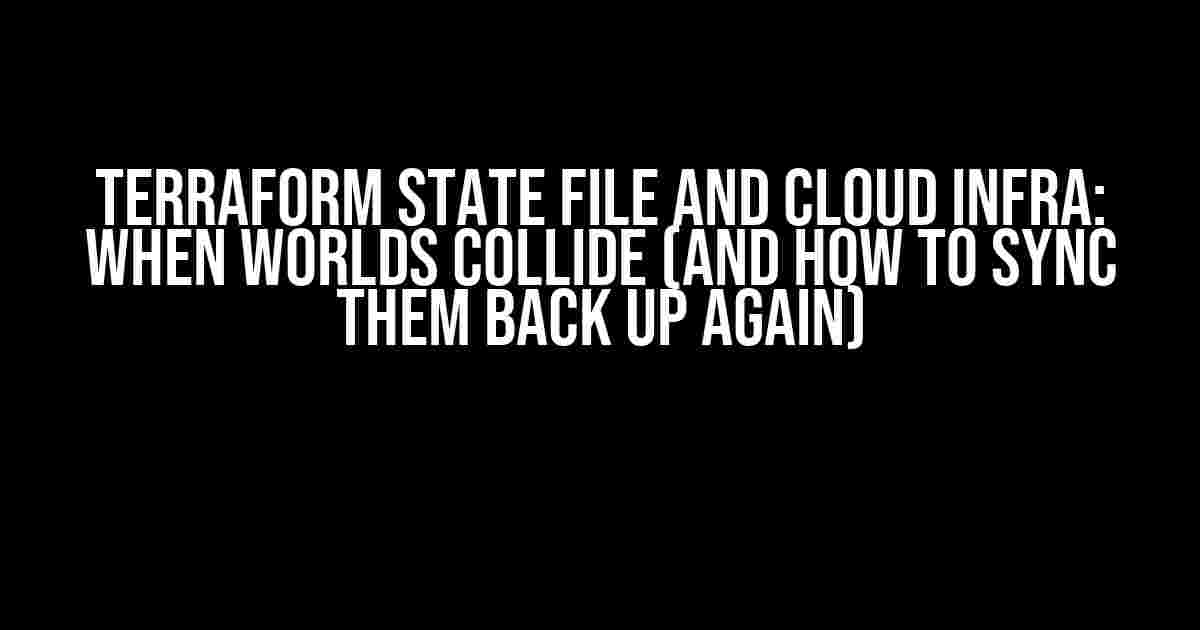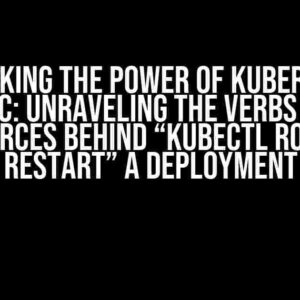Ah, the sweet harmony of Terraform and Cloud Infrastructure! When everything is in sync, it’s a beautiful thing. But what happens when Terraform’s state file and your Cloud Infra get out of sync? Chaos, panic, and a whole lot of confusion. Fear not, dear reader, for we’re about to dive into the world of Terraform state files and Cloud Infrastructure, and explore the ways to get them back in harmony.
- What is Terraform’s State File?
- What is Cloud Infrastructure?
- Why Do Terraform State File and Cloud Infra Get Out of Sync?
- Consequences of Out-of-Sync Terraform State File and Cloud Infra
- Syncing Terraform State File and Cloud Infra: A Step-by-Step Guide
- Terraform State File and Cloud Infra: A Harmonious Union
What is Terraform’s State File?
Terraform’s state file is a JSON file that stores the state of your infrastructure. It’s maintained by Terraform and contains information about the resources you’ve created, modified, or deleted. Think of it as a blueprint of your infrastructure, where Terraform keeps track of what’s been deployed and what changes need to be made.
{
"version": 4,
"terraform_version": "1.2.3",
"serial": 1,
"lineage": "abcdefg",
"outputs": {},
"resources": [
{
"address": "aws_instance.example",
"mode": "managed",
"type": "aws_instance",
"name": "example",
"provider_name": "registry.terraform.io/hashicorp/aws",
"schema_version": 0,
"values": {
"ami": "ami-abc123",
"availability_zone": "us-west-2a",
"instance_type": "t2.micro",
"private_ip": "10.0.0.1",
"subnet_id": "subnet-0123456789abcdef0",
"tags": {
"Name": "example"
}
}
}
]
}
What is Cloud Infrastructure?
Cloud Infrastructure refers to the virtualized computing resources provided by Cloud Service Providers (CSPs) like Amazon Web Services (AWS), Microsoft Azure, Google Cloud Platform (GCP), and others. It encompasses a broad range of services, including compute power, storage, databases, security, and more.
| Cloud Service Provider | Compute Service | Storage Service |
|---|---|---|
| AWS | EC2 | S3 |
| Azure | Virtual Machines | Blob Storage |
| GCP | Compute Engine | Cloud Storage |
Why Do Terraform State File and Cloud Infra Get Out of Sync?
There are several reasons why Terraform’s state file and your Cloud Infrastructure might get out of sync:
- Manual changes made directly to the Cloud Infrastructure without updating the Terraform state file
- Terraform configuration files not correctly reflecting the current state of the Cloud Infrastructure
- Resource creation or deletion not properly captured by Terraform
- Version control system (VCS) conflicts or incorrect branching
- Human error (yes, it happens to the best of us!)
Consequences of Out-of-Sync Terraform State File and Cloud Infra
When the Terraform state file and Cloud Infrastructure get out of sync, it can lead to:
- Inconsistent or incomplete infrastructure deployments
- Resources not being properly managed or updated
- Downtime or service disruptions due to incorrect configurations
- Security vulnerabilities and compliance issues
- Increased costs due to unnecessary or unused resources
- Frustration and confusion among team members
Syncing Terraform State File and Cloud Infra: A Step-by-Step Guide
Okay, let’s get our Terraform state file and Cloud Infrastructure back in harmony! Here’s a step-by-step guide to help you sync them up:
- Identify the Source of the Issue: Determine the reason behind the out-of-sync state file and Cloud Infrastructure. Was it a manual change? A Terraform configuration error? A VCS conflict?
- Update the Terraform Configuration Files: Ensure your Terraform configuration files accurately reflect the current state of your Cloud Infrastructure. Make any necessary changes to the configuration files to align with the actual infrastructure.
- Run Terraform Refresh: Execute the `terraform refresh` command to update the state file with the current infrastructure. This command will reconcile the state file with the actual infrastructure.
- Run Terraform Apply: Run the `terraform apply` command to apply the updated configuration to the Cloud Infrastructure. This will ensure the infrastructure is updated to match the desired state.
- Verify the State File and Cloud Infra: Double-check that the Terraform state file and Cloud Infrastructure are now in sync. You can do this by reviewing the state file and verifying that the infrastructure matches the desired configuration.
- Implement Preventative Measures: To avoid future out-of-sync issues, implement measures such as:
- Regularly running `terraform refresh` and `terraform apply`
- Using version control systems (VCS) to track changes and manage different environments
- Establishing a clear change management process for Cloud Infrastructure modifications
- Conducting regular infrastructure audits to detect discrepancies
Terraform State File and Cloud Infra: A Harmonious Union
By following these steps, you’ll be able to get your Terraform state file and Cloud Infrastructure back in sync. Remember, regular maintenance and monitoring are key to preventing future out-of-sync issues.
terraform {
required_version = ">= 1.2.3"
}
provider "aws" {
region = "us-west-2"
}
resource "aws_instance" "example" {
ami = "ami-abc123"
instance_type = "t2.micro"
subnet_id = "subnet-0123456789abcdef0"
tags = {
Name = "example"
}
}
Now, go forth and terraform your Cloud Infrastructure with confidence! Remember to keep your state file and infrastructure in harmony, and always be mindful of the importance of regular maintenance and monitoring.
Happy terraforming!
Frequently Asked Question
Terraform state file and Cloud Infra out of sync? Don’t worry, we’ve got you covered!
What happens when Terraform state file and Cloud Infra get out of sync?
When Terraform state file and Cloud Infra get out of sync, it means that Terraform’s understanding of your infrastructure no longer matches the actual infrastructure in the cloud. This can lead to errors, unintended changes, or even deletions of resources. It’s essential to keep them in sync to avoid these issues!
How does Terraform state file get out of sync with Cloud Infra?
There are several reasons why Terraform state file can get out of sync with Cloud Infra. Some common reasons include manual changes to the infrastructure, concurrent Terraform runs, or even Terraform configuration changes. Additionally, network failures or timeouts during Terraform operations can also cause the state file to become outdated.
What are the consequences of not syncing Terraform state file with Cloud Infra?
Not syncing Terraform state file with Cloud Infra can lead to a range of issues, including resource duplication, unintended deletions, or even security breaches. It can also cause Terraform to fail or produce unexpected results, making it challenging to manage your infrastructure effectively.
How can I prevent Terraform state file and Cloud Infra from getting out of sync?
To prevent Terraform state file and Cloud Infra from getting out of sync, it’s essential to follow best practices such as using version control for your Terraform configuration, implementing locking mechanisms, and regularly running Terraform operations to keep the state file up-to-date. Additionally, using Terraform workspaces and modules can also help to reduce the risk of desync.
What should I do if I find out that my Terraform state file and Cloud Infra are out of sync?
If you discover that your Terraform state file and Cloud Infra are out of sync, don’t panic! Instead, carefully review the changes and reconcile them manually or using Terraform’s built-in features such as the `terraform refresh` command. It’s essential to exercise caution when reconciling to avoid unintended changes or deletions.


